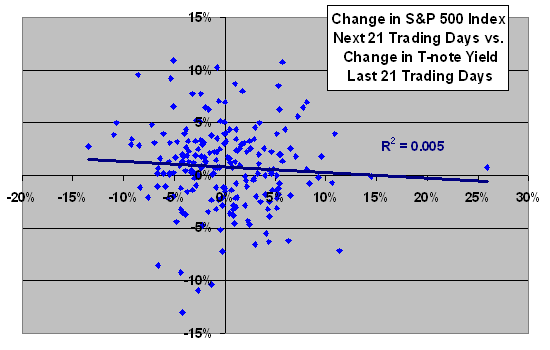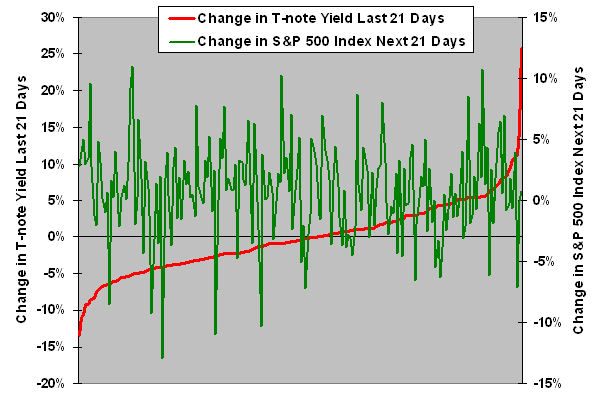A reader notes that many experts are focused on the recent sharp rise in the 10-year Treasury note (T-note) yield, often asserting that such large positive yield shocks are bad for stocks. He asks what the historical data say about the relationship between short-term shocks in T-note yield and future stock returns. Using daily closing T-note yields and daily closing prices for the S&P 500 index since the beginning of 1990, we find that:
To test the relationship, we calculate the change in T-note yield over the last 21 trading days (about one month). When T-note yields rise (fall) sharply, this change is relatively large in magnitude and positive (negative). For example, if the yield 21 trading days ago is 4%, and it is now 5%, the change in T-note yield is +25%. To avoid overlapping intervals, we select every 21st result, yielding a total of 208 independent 21-day trading periods. We then relate the selected data to changes in the S&P 500 index over the next 21 trading days. If positive shocks to the T-note yield are clearly bad for stocks, and negative shocks clearly good, a scatter plot of results should form a well-defined line sloping from the upper left quadrant to the lower right.
The following scatter plot depicts the results. Although the best-fit line slopes down to the right, the data does not tightly specify it. The Pearson correlation between the two series is -0.07, suggesting a very slight tendency for stocks to rise (fall) after T-note yields have fallen (risen). However, the R-squared statistic for the two series is just 0.0005, indicating that variation in T-note yields over the last 21 trading days explains less than 1% of the variation in stock returns over the next 21 trading days. This is not a tradable relationship.
Are there ranges (for example, the very highest or very lowest) of 21-day T-note yield shocks that reliably predict the next month’s stock returns?

To address this question, we construct an “ordered scatter plot” by ranking the 21-day changes in T-note yields from smallest (most negative) to largest (most positive) and again relating these changes to S&P 500 index returns for the next 21 trading days. The following chart shows the results. Visual inspection suggests a fairly uniform lack of relationship, but extremely negative T-note yield shocks (the largest 21-day drops in yield) look interesting.
Visual inspection can mislead. As quantitative tests, we examine the statistics for the top and bottom 20% and 10% of the T-note yield shock distribution.

The following table summarizes the extreme T-note yield stock statistics. The subsample sizes, especially for the 10% extremes, are small. A relatively few new data could therefore shift results substantially. Surprisingly, Pearson correlations are negative and average stock market returns are above the overall sample average for both the bottom 10% and the top 10% of T-note yield shocks. Average stock returns for the bottom (top) 20% of T-note yield shocks are about the same (a little lower than) the overall sample average. There are no remarkable stock return volatility behaviors for any of the subsamples. The variability of returns is fairly large compared to the differences in average returns between the subsamples and the overall sample.
The conventional wisdom regarding large positive T-note yield shocks (as defined here, the 10% largest positive monthly changes since the beginning of 1990) and stock returns is suspect.

In summary, there is practically no overall relationship between last-month change in T-note yields and next-month stock returns since the beginning of 1990. Extreme T-note yield shocks, negative and positive, may be bullish for stocks, but small subsample sizes greatly limit the reliability of this conclusion.